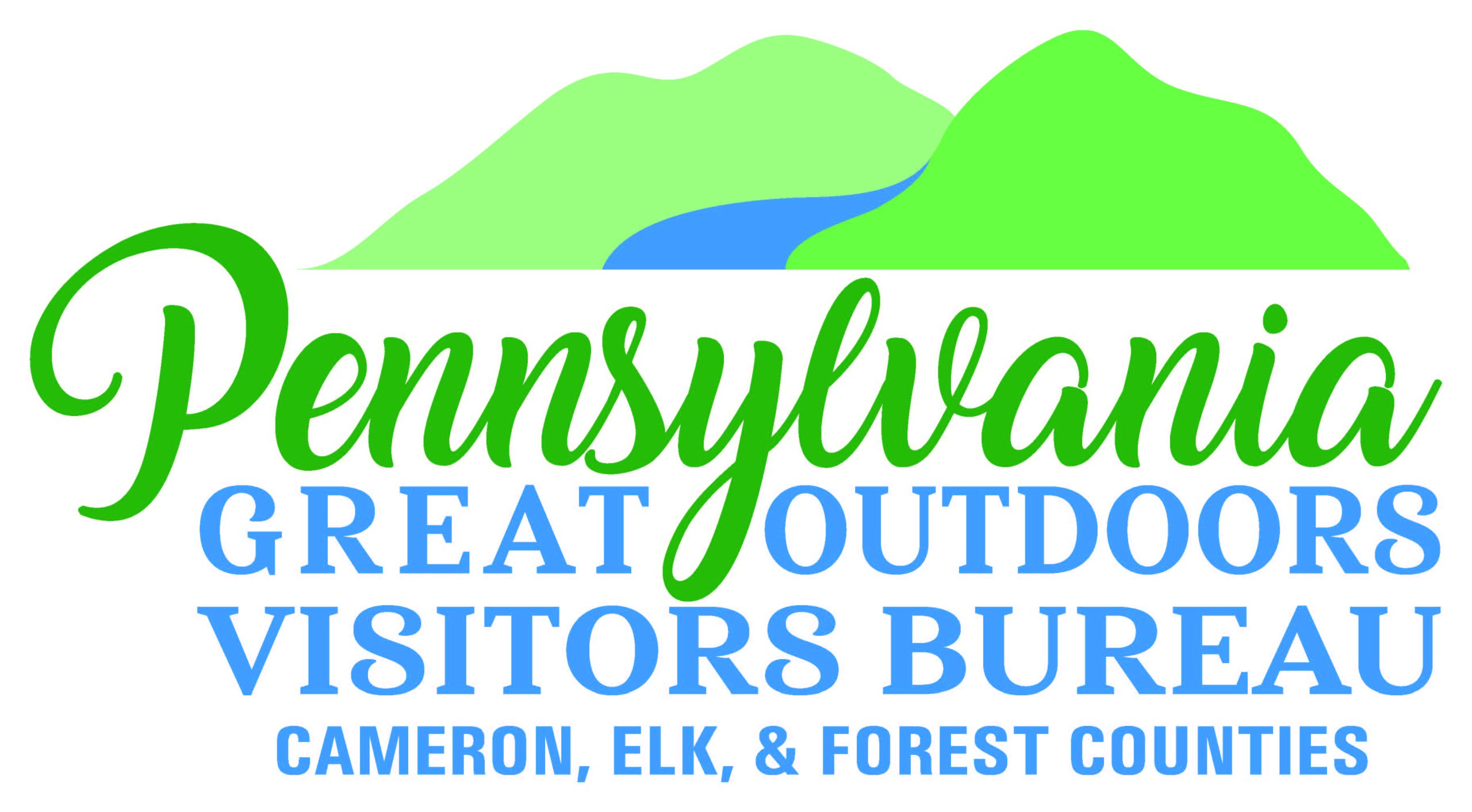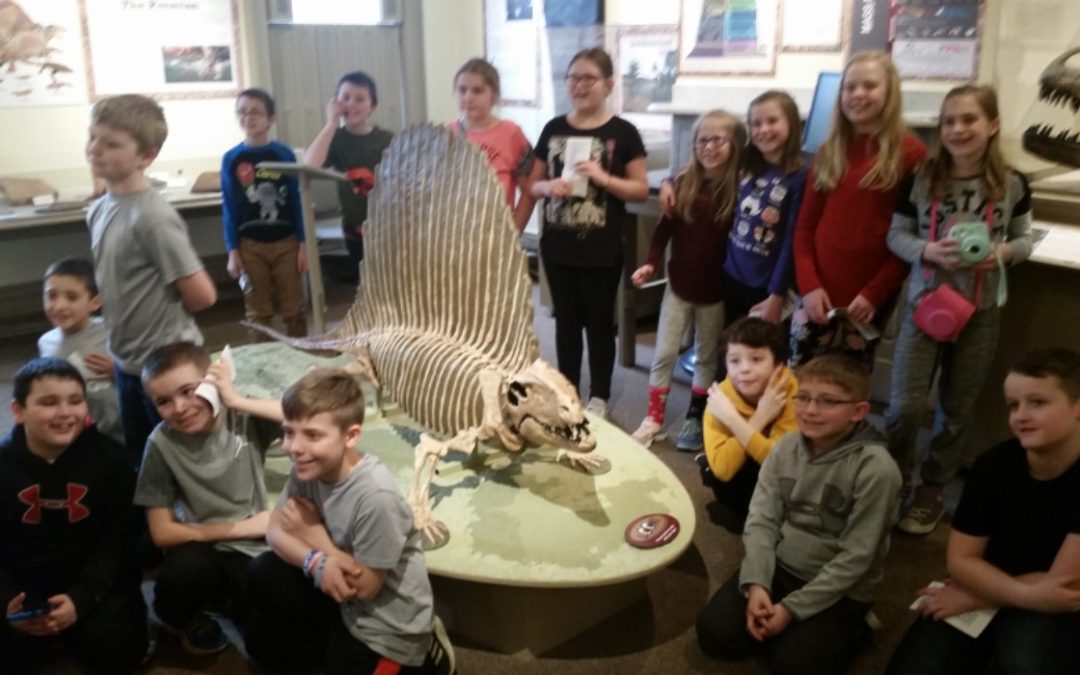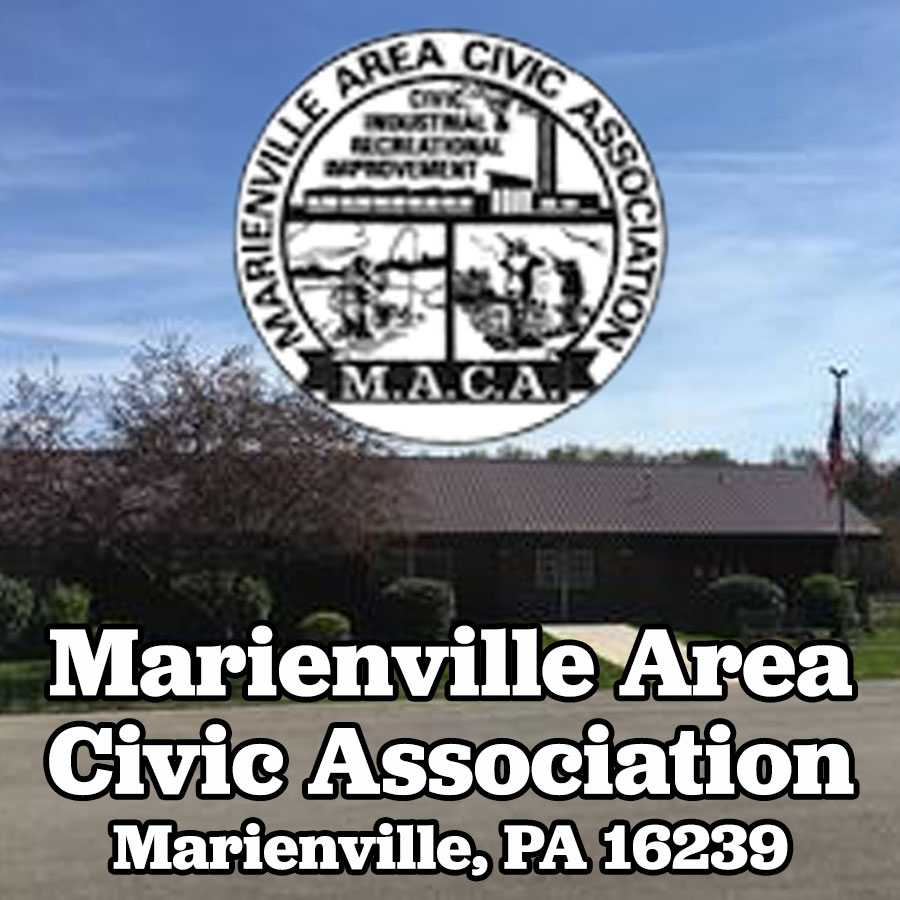Written by Kat Lyons, JCHC Staff
PA Museums’ Special Institutional Achievement Award for the Stones N’ Bones 3-Gallery Exhibit will be presented by Rusty Baker, PA Museums Executive Director to Jefferson County History Center Executive Director, Ken Burkett, at the PA Museums Annual Conference in Pittsburgh on April 20th 2020.
Institutional Awards recognize outstanding and innovative projects that provide an exemplary contribution to the museum, public history, or cultural tourism fields in PA. A nomination may be made for any project/exhibit that raises the bar of excellence in any of these fields. Some of the judging criteria considers new, innovative approaches, planning and implementing the exhibit at the highest level possible given staff size and budget limitations, and public engagement – drawing new and diverse visitors to the exhibit.
This exhibit provides local accessibility to an exhibit you would have to travel to a large city to see, such as Pittsburgh or Harrisburg.
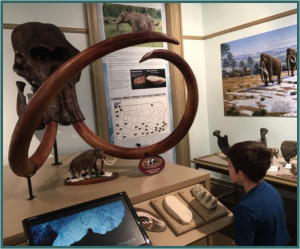 The 3-gallery exhibit which opened November 2018, incorporates Geology, Paleontology and the Ice Age of Jefferson County and western Pennsylvania. It involved extensive, long-term planning and research.
The 3-gallery exhibit which opened November 2018, incorporates Geology, Paleontology and the Ice Age of Jefferson County and western Pennsylvania. It involved extensive, long-term planning and research.
We began brainstorming and developing ideas for the layout in Fall 2017. We began our project by studying the exhibits of other institutions, taking note of innovative ways to display items, types of signage and lighting and various shaped platforms (the Mammoth Site, SD, PA State Museum, Heinz History Center, Carnegie Museum, Punxsutawney Weather Discovery Center).
We worked with other museums for fossil loans, including the Red Hill Field Station fossil site in Clinton County, famous as one of the earliest sites of tetrapods (amphibians with 4 limbs) in North America. We also dug our own fossils at this site. We acquired a massive collection of fossil seashells from a local individual. Word spread and several people – from several counties – brought us mammoth, bison, horse and camel fossil bones from the ice age era.
Our goal was to create an exciting, informative and interactive exhibit for all ages, but especially targeting elementary through middle school by connecting with local teachers and via extensive marketing. Brookville’s Hickory Grove elementary school brought in 120 3rd and 4th graders one day to see the exhibit. Such excitement you’ve never seen nor heard.
Word of the exhibit spread, and we had requests from other schools, as well as scout groups, from outside of Jefferson County—including Clarion, DuBois and Redbank Valley – that had never visited the History Center before, who now wanted to visit the Stones N’ Bones exhibit.
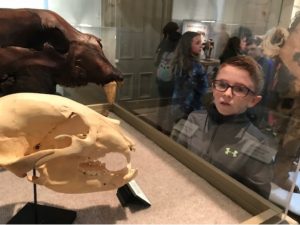 The Geology Exhibit is a hands-on “geology lab” and interactive display of the types of minerals and rocks found in Jefferson County, and the story behind our vast coal beds. It’s also a younger kid’s “rock mecca,” with a free “start you own rock collection” station. Each child can take home a small bag of glittering rocks and real coal. Middle to high school students can examine the qualities of different rocks and minerals using tools of the trade in the interactive geology lab.
The Geology Exhibit is a hands-on “geology lab” and interactive display of the types of minerals and rocks found in Jefferson County, and the story behind our vast coal beds. It’s also a younger kid’s “rock mecca,” with a free “start you own rock collection” station. Each child can take home a small bag of glittering rocks and real coal. Middle to high school students can examine the qualities of different rocks and minerals using tools of the trade in the interactive geology lab.
We also built a “coal mine shaft” where elementary kids can experience how it feels to be in the dark “underground,” complete with miner’s lamp helmet to find their way in and out of the shaft while they fill their bucket with real coal.
The Paleontology Exhibit begins with the Cambrian explosion of seafloor life to the Carboniferous Period when vast swamps—now our coal beds–covered western PA, dominated by giant dragonflies and fern-like trees; on to the fish, amphibian and reptile explosion, and to the great extinction at the end of the Permian. It also touches on the next Period, the Triassic and the first dinosaurs and why there are no dinosaurs found in Pennsylvania.
On exhibit are fossil skeletons and plants common to Jefferson County, a diversity of seafloor fossil fauna, a huge 10-foot wall-mount of an amphibian trackway (fossilized footprints) next to a skeleton of the reptile-like tetrapod that probably made the tracks, and large “hands-on fossils” for kids to touch.
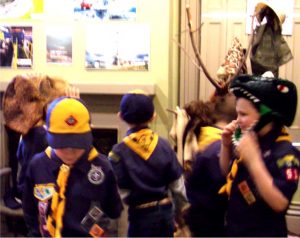 The Red Hill fossil display showcases the lobe-fin fish (which gave rise to the tetrapod amphibians) and a tetrapod fossil. An engaging video details this evolution to life on land.
The Red Hill fossil display showcases the lobe-fin fish (which gave rise to the tetrapod amphibians) and a tetrapod fossil. An engaging video details this evolution to life on land.
Two other main attractions are the 7.5 foot Dimetrodon (giant “fin-back” reptile) in the center of the room and the life-size Allosaurus (dinosaur) skull, the top predator of its time, which the kids get all excited about.
The Ice Age Exhibit begins with glaciation in the Pleistocene of the Cenozoic Era, 1.8 million years ago to about 12,000 years ago, showcasing the ice age megafauna and Paleo-Indians – thought to arrive 14,000 years ago – who survived on these giants.
Featured are the Paleo-Indian lifestyle, ice age megafauna and the environment they lived in using specimens, graphics and videos to tell their story, showcasing a life-size Paleo-Indian in replica hand-crafted dress and accoutrements. Life-size replica skulls of the woolly mammoth with 7-foot tusks and the mastodon – with actual fossils of each – are compared in ceiling to floor graphic panels of these ice age icons. A hands-on display of replica teeth teaches kids the differences in their feeding habits, allowing these giants to co-exist in proximity to one another.
Other megafauna on display are the enormous, carnivorous Short-faced Bear and Saber-toothed Cat, a caribou mount and fossil teeth of the 7-foot Western camel that roamed Pennsylvania.
The life-size Saber-tooth that greets you as you enter the Ice Age Gallery is not for the faint of heart. (The sizeable cat will replace the Paleo-Indian who will move to the Native American exhibit in the Living on the Land Gallery by February 29th, when we open new and evolving exhibits for our annual Bowdish Birthday Bash).
Just for fun is our Ice Age dress-up Selfie Station, complete with cave man/cave woman outfits, dinosaur masks, Native 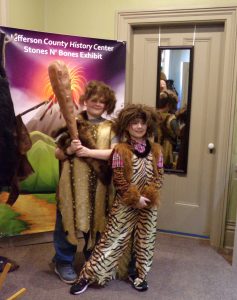 American and Archaeology explorer outfits, which has been an extremely popular attraction for the kids.
American and Archaeology explorer outfits, which has been an extremely popular attraction for the kids.
Last, but not least is our street window display announcing our new exhibit. We constructed a gigantic “boulder” announcing the “Stones N’ Bones” exhibit, and mounted dinosaur and other reptile heads to appear as bursting out of the woodwork, attracting quite some attention from passers-by.
The Man Behind the Mission
This exhibit is the brainchild of our Executive Director, Ken Burkett and could not have been possible without Ken’s knowledge of geological processes, paleontology and archaeology. Ken is a Field Associate with Carnegie Museum of Natural History, Treasurer of the Society for Pennsylvania Archaeology (SPA) and President of the local North Fork Chapter 29, SPA. He is well known for his archaeological work and as a petroglyph expert. His life actually revolves around “stones and bones,” hence the title of the exhibit.
This exhibit has been a year-long project in the physical sense, but for Ken, years in the making conceptually. In reality, this undertaking was a multi-year mission. His perseverance that someday an exhibit of this magnitude might be possible at our small museum and his expertise in implementing it can inspire us all.
Ken oversaw all aspects of the planning and development of the exhibit right down to the special “bone fonts” and borders for the panels used in the exhibit, the new exhibit cases and platforms that were necessary, as well as finding the funding we needed. He identified what materials and items were needed and managed to obtain them. Many of the fossils and Indian artifacts and accoutrements are from his own collections and those of North Fork Chapter 29.
Ken also oversaw two CUP Geology and Geoscience interns, which we were fortunate to have, in researching and planning the Geology exhibit.
His connections with exhibit sponsors Billman Geologic (Pittsburgh), Rosebud Mining (Kittanning), Matson’s Lumber & Insurance (Brookville) and Janny-Lerch Group (Clarion) as well as the Red Hill Field Station & Fossil Museum and Carnegie Museum made this exhibit possible.
Ken has shown this community that the History Center has the capacity to showcase a “big city exhibit,” albeit within the limitations of our small museum budget, staff size, and space limitations.
Visitors from other states tell us how surprised they are to see such an exhibit in our little town museum and how impressed they are by it. They want to know how we managed to put it all together. The answer to that question is simple: Ken Burkett’s vision, historical knowledge, connections and perseverance.
The nomination originally requested was for an Individual Special Achievement Award for Ken, but since he received both Institutional and Individual Awards for JCHS Scripture Rocks Heritage Park in 2017, PA Museums decided on giving us an Institutional Award for the exhibit. (That year we also received the American Association for State and Local History Award of Merit for the Park, a national award).
PA Museum’s Rusty Baker stated: “The Awards Committee appreciates your hard work and how central you are to your organization, and they decided not to name you as an individual award winner because you were recently recognized with one. We hope you understand this decision does not diminish the outstanding work you and your organization are doing…Look forward to seeing you in April at the conference and awards.”
Either way, it is still Ken’s achievement. We are fortunate to have our small town museum as well as the” Man Behind the Mission.”
For more information on the history of the Pennsylvania Great Outdoors or the current events in the PA Great Outdoors, go to VisitPAGO.com.
